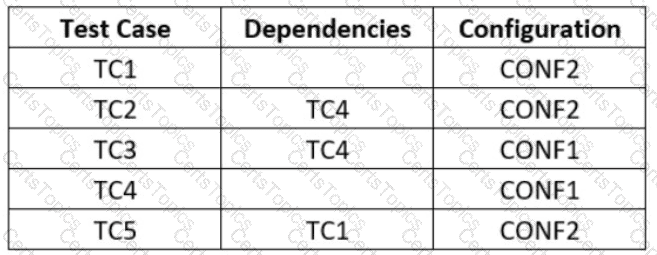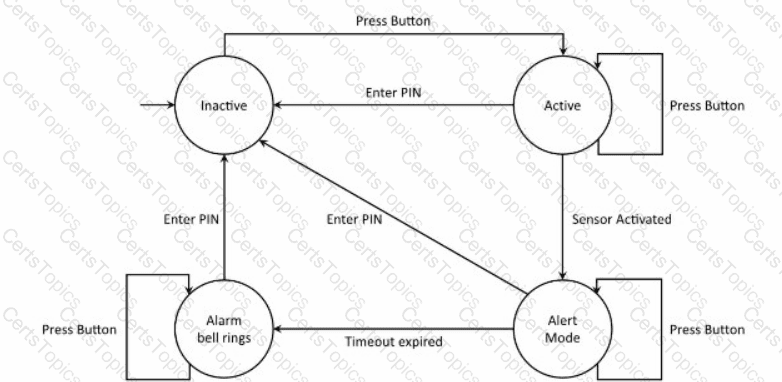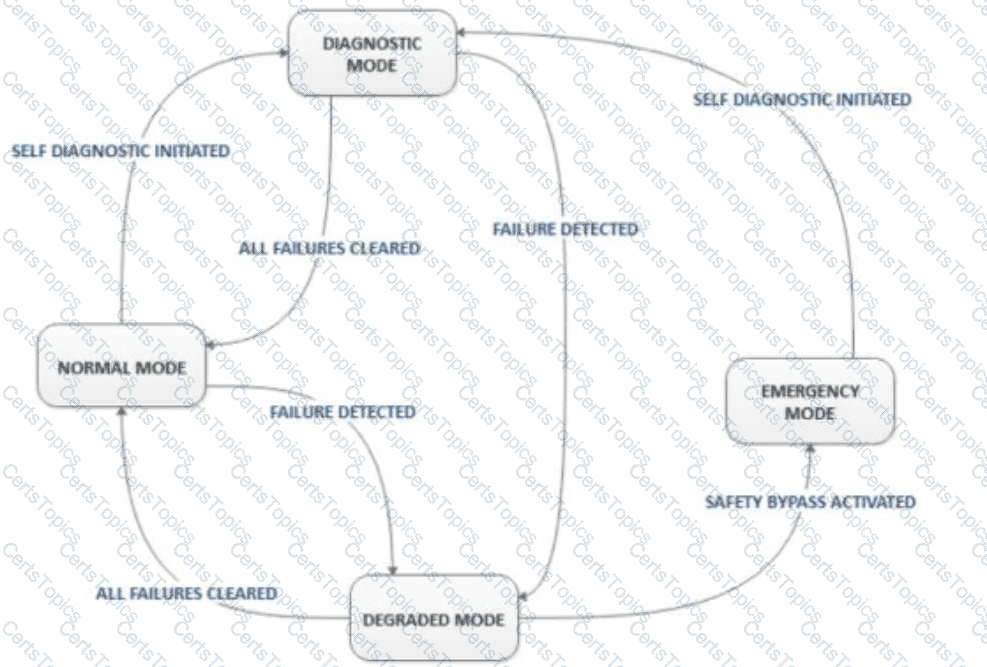For each test case to be executed, the following table specifies its dependencies and the required configuration of the test environment for running such test case:

Assume that CONF1 is the initial configuration of the test environment. Based on this assumption, which of the following is a test execution schedule that is compatible with the specified dependencies and allows minimizing the number of switches between the different configurations of the test environment?
Which ONE of the following options isNOTa benefit oftest automation?
A typical objective of testing is to ensure that:
Which of the following is a good testing practice which is applicable INDEPENDENT of the software development lifecycle followed?
Consider the following examples of risks identified in different software development projects:
[I]. The contrast color ratio for both normal text and large text of a website does not comply with the applicable accessibility guidelines, making it difficult for many users to read the content on the pages
[II]. A development vendor fails to deliver their software system on time, causing significant delays to system integration testing activities that have been planned as part of a development project for a system of systems
[III]. People in the test team do not have sufficient skills to automate tests at the test levels required by the test automation strategy which does not allow production of an effective regression test suite
[IV]. In a web application, data from untrusted sources is not subject to proper input validation, making the application vulnerable to several security attacks
Which of the following statements is true?
Which of the following is a role that is usually responsible for documenting the findings (e.g., action items, decisions, recommendations) made by the review team as part of a typical formal review?
Which of the following statements about the value of maintaining traceability between the test basis and test work products is not true?
Which ONE of the following options BEST describes the purpose of confirmation testing versus regression testing?
Which of the following statements describes regression testing?
I. Retesting of a fixed defect
II. Testing of an already tested program
III. Testing of new functionality in a program
IV. Regression testing applies only to functional testing
V Tests that do not nave to be repeatable, because They are only used once
Consider a program that computes the factorial of a number (n). From the specifications you know that:
•If n < 0, a message "Value out of range" must be issued.
•If 0 < n < 100, the program calculates the factorial and returns the number
•If 100 < n < 200 message "Value out of range" must be issued
Which of the following statements about the equivalence partitions is CORRECT?
Which of the following is NOT a typical debugging activity when a failure is triggered by dynamic testing?
An alphanumeric password must be between 4 and 7 characters long and must contain at least one numeric character, one capital (uppercase) letter and one lowercase letter of the alphabet.
Which one of the following sets of test cases represents the correct outcome of a two-value boundary value analysis applied to the password length? (Note: test cases are separated by a semicolon)
Which ONE of the following options MOST ACCURATELY describes the activities of “testing” and “debugging”?
Who of the following has the best knowledge to decide what tests in a test project should be automated?
Which ONE of the following work products TYPICALLY belongs to test execution?
Which of the following statements about the shift-left approach is true?
Which ONE of the following options identifies the acceptance criteria that has NOT been fully covered during the above test cycle?
A system has a self-diagnostics module that starts executing after the system is reset. The diagnostics are running 12 different tests on the systems memory hardware. The following is one of the requirements set for the diagnostics module:
'The time taking the diagnostics tests to execute shall be less than 2 seconds' Which of the following is a failure related to the specified requirement?
Which of the following about typical information found within a test plan is false?
Which of the following statements is true?
A document describes the test procedures that have been derived for the identified test sets. Among other things, the order in which the test cases in the corresponding test set are to be executed according to the dependencies described by preconditions and postconditions is specified. This document is a typical work product produced as part of:
Exploratory testing is an experience-based test technique:
Which of the following statements about the test pyramid is true?
Following a risk-based testing approach you have designed 10 tests to cover a product risk with a high-risk level. You want to estimate, adopting the three-point test estimation technique, the test effort required to reduce the risk level to zero by executing those 10 tests. You made the following three initial estimates:
• most optimistic = 6 person hours
• most likely = 30 person hours
• most pessimistic = 54 person hours
Based only on the given information, which of the following answers about the three-point test estimation technique applied to this problem is true?
Shripriya is defining the guidelines for the review process implementation in her company. Which of the following statements is LEAST likely to have been recommended by her?
Which of the following statements about static testing and dynamic testing is true?
An anti-intrusion system is battery powered and is activated by pressing the only available button. To deactivate the system, the operator must enter a PIN code. The system will stay in alert mode within a configurable timeout and an alarm bell will ring if the system is not deactivated before the timeout expires. The following state transition diagram describes the behavior of the system:

What is the minimum number of test cases needed to cover every unique sequence of exactly 4 states/3 transitions starting and ending in the “Inactive” state? (note that “Inactive” is not a final state in the diagram)
Which of the following statement about the shift-left approach is false?
A requirement specifies that a certain identifier (ID) must be between 5 and 10 characters long, must contain only alphanumeric characters, and its first character must be a letter. As a tester, you want to apply one-dimensional equivalence partitioning to test this ID. This means that you have to apply equivalence partitioning individually: to the length of the ID, the type of characters contained within the ID, and the type of the first character of the ID.
What is the number of partitions to cover?
Consider an estimation session in which a six-member Agile team (Membl,..., Memb6) uses the planning poker technique to estimate a user story (in story points). The team members will use a set of cards with the following values: 1. 2, 3, 5, 8,13, 21. Below is the outcome of the first round of estimation for this session:
Membl = 3 Memb2 = 3 Memb3 = 3
Memb4 = 21 Memb5 = 3 Memb6 = 1
Which of the following answers best describes how the estimation session should proceed?
Which of the following is a factor that contributes to a successful review?
Which of the following statements about checklist-based testing is true?
Which ONE of the following options corresponds to an activity in the testing process in which testable features are identified?
Which of the following is a typical potential risk of using test automation tools?
The following decision table is used to assist a doctor in determining the drug therapy to prescribe for a patient (aged 6 to 65 years) diagnosed with acute sinusitis. The table consists of three Boolean conditions and six actions:

Based only on the given information, which of the following statements is true?
Which ONE of the following statements would you expect to be the MOST DIRECT advantage of the whole-team approach?
Which of the following statements about TDD, BDD and ATDD is true?
Which of the following statements is CORRECT about White-box testing?
Consider the following user story about the authentication functionality of an e-commerce website:
"As a logged-in user, I want to change my current password with a new one, so that I can make my account safer".
The following are some of the acceptance criteria defined for the user story:
[a] After the logged-in user has successfully changed his password, an email confirming the change must be sent to him
[b] To successfully change the password, the logged-in user must enter the current password, enter a new valid password, and finally confirm by pressing the 'Change Password' button
[c] To be valid, the new password entered by the logged-in user is not only required to meet the criteria related to the length and type of characters, but must also be different form the last 5 passwords of that user
[d] A dedicated error message must be presented to the logged-in user when he enters a wrong current password
[e] A dedicated error message must be presented to the logged-in user when he enters the correct current password, but enters an invalid password
Based only on the given information, which of the following ATDD tests is most likely to be written first?
Mark the correct sentences:
* Defects are a result of environmental conditions and are also referred to as "Failures"
* A human mistake may produce a defect
* A system mil totally fail to operate correctly when a failure exists in it
* When a defect exists in a system it may result in a failure
* Defects occur only as a result of technology changes
Which of the following statements is true?
Which ONE of the following options explains a benefit of independent testing the BEST?
Which of the following statements is true?
Your organization's test strategy states that it is desirable to usemore than one method for estimating test effort. You are responsible for estimating test effort for the next project. Based on historical data, thedevelopment-to-test effort ratiois5:3.
The initial estimate for thedevelopment effort is 450 person-days.
Which ONE of the following options corresponds to the estimatedtest effortusing the ratio-based method?
In branch testing, what is the significance of a conditional branch in a software program?
Use Scenario 1 “Happy Tomatoes” (from the previous question).
Using theBoundary Value Analysis (BVA)technique (in its two-point variant), identify the set of input values that provides the HIGHEST coverage.
During component testing of a program if 100% decision coverage is achieved, which of the following coverage criteria is also guaranteed to be 100%?
The following state transition diagram describes the behavior of a control system in terms of its possible modes of operation. The initial start state will be the “NORMAL MODE”.

Which ONE of the following test cases covers an INVALID sequence?
Consider the following table, which contains information about test cases from the test management system:

Which ONE of the following optionsorganizes the test cases based on the statement coverage strategy, while considering practical constraints?
Which of the following statements about statement coverage is true?
An agile software development organization has recently hired a senior tester. The organization has distributed teams spread across time zones. They need to share test status with various stakeholders including upper management and customers at a regular interval. Which of the following statements seems to be correct with regards to the communication?
Which of the following statements about the typical activities of a formal review process is true?
Scenario 2 “Big Drop”:
The management of the company “The Big Drop” has instructed the Product Team to configure the discounts in the sales terminals so that frequent customers receive an additional discount on top of a bulk discount, based on the following table:

Question:
You must design test cases to represent allPOSSIBLEandREALbusiness scenarios. Test cases should be generated using the input data provided in the table above.
How many POSSIBLE decision rules can be extracted from the table above?
Which ONE of the following options is aPRODUCT riskand NOT aPROJECT risk?
The four test levels used in ISTQB syllabus are:
1. Component (unit) testing
2. Integration testing
3. System testing
4. Acceptance testing
An organization wants to do away with integration testing but otherwise follow V-model. Which of the following statements is correct?
Confirmation testing is performed after:
Which ONE of the following elements is TYPICALLY part of the test plan?
Which of the following is an advantage of the whole team approach?
A number of characteristics are given for impact of SDLC on the testing effort.
i.Finishing of requirements review leading to test analysis
ii.Both - static and dynamic testing performed at unit testing level
iii.Frequent regression testing may need to be performed
iv.Extensive product documentation
v.More use of exploratory testing
Which of the following statements is MOST correct?